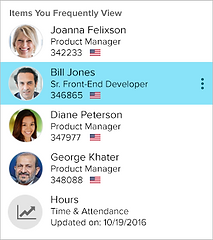Overview
Timeline: 2 months
Objective: Create a search experience strategy and design patterns at the Enterprise level that 200+ products could take advantage of to implement for their own product's search feature.
Team:
-
John: UX Researcher
-
Weston: UX Architect, Development Liaison
-
Me: UX Designer, COE Strategist, COE
John and Weston kicked off the research.
Prior to my involvement at ADP, John and Weston started looking at how search was being used by our 200+ products to help practitioners, managers, and employees complete tasks related to HR functions and how we can centralize best practices and designs between products.
John tackled interviewing product teams and users about their current experiences while Weston looked to the industry to learn search terminology and functionality.
They also worked with the Enterprise Search (ES) team to look into what functions were technologically available to us today that products could use.
Industry Research

Reviewed books, articles, and published studies.
Key Takeaways:
-
There are over 50 design patterns we could implement to support a variety of search use cases
-
The majority of the search experience lies in the functionality of facets and narrowing results
User Research

Interviewed and performed user testing of current site with 40 users.
Key Takeaways:
-
Users aren't using search today because it isn't answering their questions
-
Users need to search across many different data scopes (federation)
-
Many products are looking to implement search soon
Developmental Research

Discussed technological capabilities with ES dev team.
Key Takeaways:
-
ES supports really advanced functions, such as federated and predictive search
-
Teams must really understand their data to utilize search
-
Performance is a key deterrent of an ideal search experience
We created a priority list.
With teams wanting to implement a good search experience soon, we wanted to get guidance and designs out sooner rather than later.
Weston had created a list of the top 50 search patterns and we cut it over half to 25 key focus areas.

We then did some user testing on
some design ideas.
Taking into account the research done by John and the industry research done by Weston, we did some quick mock ups to look at what resonated with users.
Search Query Dropdown, Various Stages

Started simple.

Added images

Added descriptions, made images bigger

Made descriptions more visual, added actions
During design, I followed the motto:
K.I.S.S. (keep it simple, stupid.)
As a SaaS company where all products are used during one's daily job, we weren't looking to reinvent search. We focused on making it work for users by making it familiar.
To do this, I looked to many websites our users indicated they use on a daily basis that have an emphasis on search, so that we could use patterns familiar to them.
For example, analyzing single and multiple select facets:
Sites Reviewed:
-
Amazon
-
Ebay
-
LinkedIn
-
Home Depot
-
Walmart
-
Target
-
Facebook
-
Seamless
-
Opentable
-
Office Depot
-
Barnes and Noble
-
Monster
-
Indeed
-
Trip Advisor
-
Best Buy
-
Zappos

Key takeaways:



Use checkboxes as affordance for multi-select.
Maintain visual consistency around selected elements.

Provide modal for long facet lists.
We also provided guidance on how to build search, and how different pieces interact.
As the enterprise strategy for design team, we do not implement our own designs, so we must explain the designs patterns, visual style guide, alignment considerations, and animations.
We also provide guidance on how to build a great search experience and make decision decisions.
For example, we help guide to which layout to choose for their result lists.

We then provide details on each pattern, including behavior of how the patterns interact with each other.
For example, we go in depth on how facet counts interact when chosen.

Both product teams and end users
loved our designs.
End users were very comfortable using our search design to perform key tasks. They jumped into the system and some even completed tasks within 5 seconds!
User Satisfaction Score

User Task Completion Rates

Enterprise Search Experience
ADP

I did:
-
Priority management
-
Comparative analysis
-
User testing test creation
-
Research analysis
-
Wireframing
-
Invision prototyping
-
Component breakdown
-
Dev hand-off
-
Guidance research and creation
John did:
-
Recruiting
-
User interviews
-
User testing
Weston did:
-
Industry research leading to search pattern identification and list
-
Current search experience analysis
-
Dev liaison